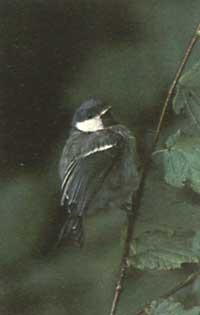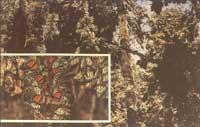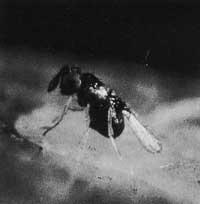Pine Terror: A Dangerous Plague
1994/05/01 Elosegi Irurtia, Migel M. Iturria: Elhuyar aldizkaria
Biology or lifestyle of pine caterpillar
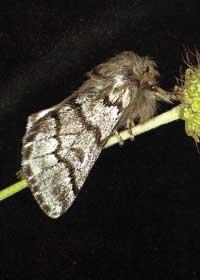
This small insect and fires are the two biggest enemies of pine breeding driven by our Administration in recent decades. The caterpillar of this pinar lepidopter is known for eating pine cucumbers and originating large defoliations.
The thaumetopo pityocampa, the processionary or the caterpillar of pine, is a Mediterranean gautan lepidopter, although it reaches the center of Europe. The butterfly has a wing width between 31 and 39 mm, with a gray or whitish color. The female is characterized by golden scales at the end of the abdomen and the male by presenting thick hairy antennas.
In summer, on the nights of July/August, butterflies leave the subsoil to the surface accompanied by a jet called “canthus” located on the forehead. After going outside, the wings widen and fly in search of reproducers. It must be said that the days that butterflies live do not eat. Because they have no tubes or jaws.
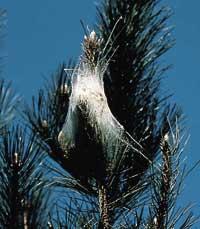
The female butterfly expels the abdominal gland that secretes the sexual pheromones to attract the males and after meeting and copulating the couples, the male dies. The female will live a little longer, placing in the leaves of a pine between 120 and 300 eggs of white and red color.
Between 30 and 40 days later the caterpillars that are part of the group will be born and then they will feed on pine needles. From birth to butterfly, these caterpillars will go through five stages or stages of development, in which they will have to change the cuticle or outer cover to increase in size. From the second stage, caterpillars develop a resentable defensive system consisting of yellow and orange hairs that can cause a reaction in people's eyes, skin and airways.
For the development of the herbaceous colony, the ideal temperature is twenty degrees Celsius, and to protect it, rest and compensate for temperature changes, make the well-known white nests of caterpillars. However, with an approximate temperature of -15 (C) they can die of cold and heat above 32 (C) destroy the colony.
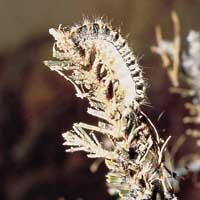
When the caterpillars leave the nest and go to the pine to eat the pine, they are called processionists. The caterpillars of the procession create a silk thread that will be the way to return to the nest and stick it on the ground, and if that thread is removed, the procession will continue bankrupt, perhaps until fear dies.
Caterpillars will spend the whole winter eating pine cucumbers and will be ready to become butterflies by March. In mid-March or April it will be the last procession and when the caterpillars reach their favorite place, they will accumulate and bury each other moving together. Once buried, each herb separates and becomes a chrysalis.
For the development of chrysalis you can spend a season of three months to five years, among which is the diapausa.
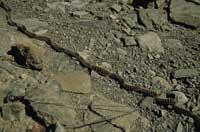
At this time called diapausa there is no development, which is a very important system so that the expulsion of butterflies does not occur until the optimal temperature of summer. On other occasions, when they have caused a great defoliation in a pine forest, the caterpillars are buried and in this phase of diapausa remain several years, giving time to the pine forest to recover forces and ensuring food for the development of the colony.
Damage
First of all, it must be said that due to the pine cucules ingested by the caterpillars, the pines are difficult to die. What happens is that, on the one hand, the production of pine descends (because for the photosynthesis has to develop again the leaves) and, on the other, the pine weakened by the caterpillars is more vulnerable to other pests. Therefore, the pine defoliated and weakened by the caterpillars will not have resistance to piercing or other similar insects, facilitating the drag of the pine.
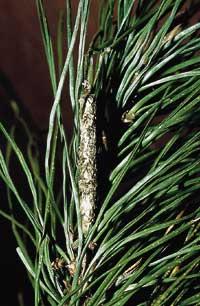
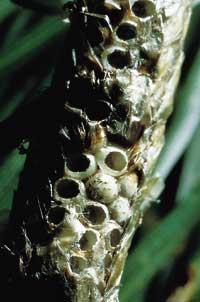
Chemical treatment against caterpillars, on the other hand, costs a lot of money, so the profitability of pine crops decreases. Considering that in the Autonomous Community of the Basque Country conifers cover more than 200,000 hectares and that the most abundant is the species Pinus radiata, of which the caterpillar likes so much, millions of pesetas are spent in the chemical treatment of the caterpillar pest. In fact, the cost of chemical treatment per hectare stands at 2,500 pesetas.
Finally, it should be noted that the mountains of Euskal Herria are suitable for an epidemic of caterpillar in the pine forests (due to mild temperatures and high density of pine forests). The monospecific pine forests of our mountains are less resistant than the mixed forests to combat caterpillars pests. In fact, in mixed forests, trees that cannot be damaged by the insect are mechanical barriers, predators and parasites are more distinct and abundant, and in monospecific forests the abundance of homogeneous food offers caterpillars a great opportunity to become a pest.
Fighting the pine tremor
There are several methods to keep caterpillar populations at low levels of information. The best known are:
Chemical treatments
Currently there are two main groups: development inhibitors and microbiological insecticides.
- Among the development inhibitors, diflubenzurone marketed under the name “Dimilin” stands out. This prevents the synthesis of the chitin that constitutes the outer cover or cuticle of the insect, and by passing the caterpillars from one stage of development to another, they die without being able to form a new one.
These products are quite expensive and also it is recommended to use them when the epidemic is moderate. When the plague is large and the pines are defoliating, it is better for the caterpillars to starve. In this situation, by casting Dimilina, not only the caterpillars can be reduced, but also the insects and birds that catch them, leaving the caterpillar without enemies for another period of information. - Microbiological insecticides are based on Bacillus Thuringensis bacillus and are biodegradable natural products of great specificity. The caterpillar introduces the insecticide by ingestion, paralyzing the mouth and dying afterwards.
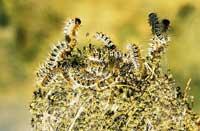 Caterpillars killed by the cold. The cold pushes the caterpillars to protect the nest and kills them if caught outside or the nest is not well protected.
Caterpillars killed by the cold. The cold pushes the caterpillars to protect the nest and kills them if caught outside or the nest is not well protected.
Nesting cutting and removal
This is the classic fight against panic. It is simple in young pine groves and is recommended for foresters. Nests, starting in December, will be cut and burned one by one with long scissors, which must end before burying the caterpillar in spring.
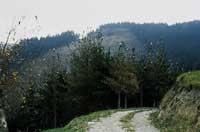
Due to the resentful hairs of the caterpillars, it is recommended to do the work with glasses, gloves and wind behind.
Nests can also be cut to shots in larger trees, but not only expensive, but also greatly reduces the branch.
Pheromone Traps
In 1981 we obtained the synthesis of the sexual pheromone of the female of pines and invented the trap for the capture of the males. These traps, rather than to control the epidemic, are used to check the degree of the pest and, from mid-June, by placing traps on the pine branches, good results are obtained in the capture of males.
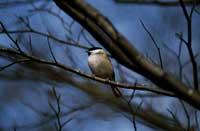
The operation of these traps is very simple: in a plastic bag a pheromone is placed to attract the males, who get into a groove located above in search of the female, without being able to remove it later. By placing some traps of these, we can know when and how much butterflies come out of the subsoil, and then use other control techniques.
Biological fight
The resentful hairs of caterpillars make you think you have no enemies or predators that you can eat. But there are diseases and parasites of herbs, chrysalis and eggs, and also predators. The most important are the cuckoo, the rooster of light, the chargers and the red ants.
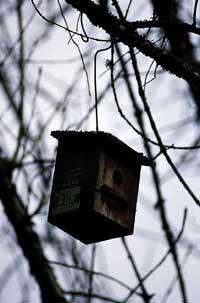
insectivores. The holes of the boxes must have a diameter of 34 mm and the boxes will be placed away from the trunk to prevent them from attacking the piztias.
Bats, on the other hand, are great enemies of butterflies coming out of the ground. All of them, therefore, offer us great help in the fight against pine tremor and other pests. For our part, we can place nest boxes in the pine forest to have more coal and other insectivores. By placing a metal mesh on the top in the same boxes, we can have bats that are the great enemy of butterflies.
Also the red ants of the genus Formica fight for many pests, completely cleaning their territory and installing anthills can have good results.
When and how to act?
The epidemic never happens suddenly. Initially, isolated pines and those on the edge of the forest will carry some nest. Little by little nests will appear throughout the forest and in two or four years some trees of the riverside of the pine forest will appear defoliated. Finally, in 6-8 years the defoliation can be total.
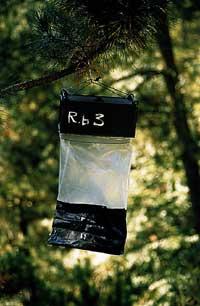
Therefore, it is best to catch the scissors and eliminate those first nests. With the help of pheromone traps and insectivores you can control the epidemic. However, if we do not initially control it, the whole pine forest can be filled with fear, causing defoliation. While this happens, chemical treatment can be used, but when the level of information is very high, they run out of food and caterpillars starve or bury themselves waiting for a better time. Therefore, the use of poison does not help too much, since we will reduce the rest of predators and the pine forest will not have protection behind the diapausa.
As we have seen, the pine forests must be taken care of a little so that they are not damaged by this type of pests, and from the beginning the caterpillars can be easily maintained at levels without danger.
Act as soon as possible!
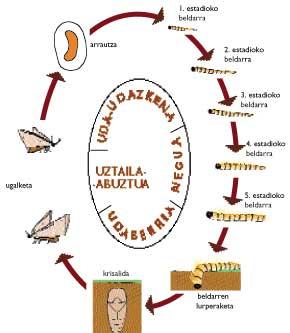

Gai honi buruzko eduki gehiago
Elhuyarrek garatutako teknologia




